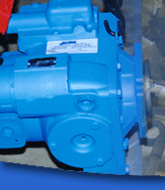

|
|
ServoCon ALPHA has been a leader providing and servicing hydraulic valves worldwide since 1979. These valves are a part of the hydraulic circuit in most hydraulic systems. Sometimes hydraulic valves are called servovalves, strokers, unloaders, flow control, pressure control, relief, solenoid, check, the names go on and the types are numerous.
Hydraulic valves are offered in many ranges to satisfy the needs of the fluid power industry. Flow sizes range between 0.25 to 225 US gpm (1 to 900 lpm) and working pressures up to 7000 psi (500 bar) are available. Some designs are produced in an intrinsically safe version for use in hazardous environments including process plant, power generation and on underground mining equipment. They also perform many functions and they may be controlled electrically or mechanically. Hydraulic valves range from the interface between low energy electrical signals and high horsepower hydraulic power to simple directional and flow devices that are manually controlled.
 |
 |
 |
Servovalves are by far the most complex. Servovalves are electrically operated, they may be proportionally controlled, may provide directional flow or may be pressure controlled. They are usually four ported units incorporating a four land, closed center spool, sliding either in a bushing or, directly in a valve body. Servovalves usually have rectangular porting offering fluid flow in proportion to spool displacement. Unlike "on-off" solenoid valves, the spool is positioned proportionally to the applied electrical signal thus enabling control of magnitude as well as direction of fluid flow.
[ < back to top ]
| Home | Markets | Product Solutions | Corporate | Customer Support | Downloads | What's New | Contact Us |